使用 linux kernel +busybox 定制linux系统
目的:
了解linux的启动过程
主要内容:
1.grub 是启动程序的bootloader
2.linux-kernel 是linux的开源内核
3.busybox 是linux的工具集合
启动顺序:
grub-> bzimage > initrd > init > chroot sbin/init (从内存镜像转换成rootfs)>/etc/inittab > fstab>etc/init.d/rcS
实验环境:
操作系统(编译使用): CentOS 7.4Kernel 版本 :5.5.2
1.编译linux kernel
- 下载及解压:
https://www.kernel.org/
目前最新版本5.5.2
https://cdn.kernel.org/pub/linux/kernel/v5.x/linux-5.5.2.tar.xz
复制文件到 /usr/src/linux-5.5.2.tar.xz
解压 tar -xvf linux-5.5.2.tar.xz2)编译linux kernel:
1 yum install ncusres‐devel # 按照需要编译的一些包
2 cd /usr/src/linux‐5.5.2 # 切换到linux源代码目录
3 make menuconfig #配置内核编译内容,配置一些信息 ,由于是演示,默认就可以了
4 make ‐j4 #执行多cpu方式编译
5 midir /usr/src/modules
6 make modules_install INSTALL_MOD_PATH=/usr/src/modules #将modules安装在这里2.编译busybox
- 下载及解压:
https://busybox.net/
目前最新版本1.31.1
https://busybox.net/downloads/busybox-1.31.1.tar.bz2
复制文件到 /usr/src/busybox-1.31.1.tar.bz2
解压 tar -jxvf busybox-1.31.1.tar.bz2- 编译busybox
1 yum install glibc‐static # 按照需要编译的静态库包
2 cd /usr/src/busybox‐1.31.1 # 切换到busybox源代码目录
3 make menuconfig # 配置 Settings‐>Build Options‐>Build static binary
4 make install3.根据busybox 制作initrd.gz文件
1 make /usr/src/initrd # 创建初始化目录
2 cd /usr/src/initrd # 进入工作目录
3 cp /usr/src/busybox‐1.31.1/_install/* ‐a . #复制所有busybox文件
4 mkdir proc sys mnt/sysroot dev tmp etc ‐pv #创建必要的目录
5 mknod dev/console c 5 1 # 创建console设备
6 mknod dev/null c 1 3 # 创建null设备
7 rm linuxrc # 删除软连接,这个文件没啥用看着不舒服而已
8 touch init # 创建init 引导程,具体内容见下面信息
9 chmod +x init # 设置可运行程序
10 find . | cpio ‐H newc ‐‐quiet ‐o | gzip ‐9 > /usr/src/initrd.gz #打包initrdinit 文件内容:
1 #!/bin/sh
2
3 echo "Mounting proc and sys..."
4 mount ‐t sysfs sysfs /sys
5 mount ‐t proc proc /proc
6
7 echo "Detect and export hardware infomation..."
8 mdev ‐s
9
10 echo "Mount real rootfs to /mnt/sysroot..."
11 mount ‐t ext4 ‐o ro /dev/sda2 /mnt/sysroot
12
13 echo "Switch to real rootfs..."
14 exec chroot /mnt/sysroot /sbin/init4.根据linux kernel 编译输出整理成 vmlinuz
1 cp /usr/src/linux‐5.5.2/arch/x86/boot/bzImage /usr/src/vmlinuz #复制内核5.根据busybox 制作rootfs 系统真正的linux目录
1 make /usr/src/sysroot #创建工作目录
2 cd sysroot #进入工作目录
3 cp /usr/src/busybox‐1.31.1/_install/* ‐a . #复制所有busybox文件
4 rm linuxrc # 删除软连接,这个文件没啥用看着不舒服而已
5 # 创建目录
6 mkdir dev var sys mnt etc proc lib home tmp root boot
7 mkdir var/{log,run,lock}
8 mkdir lib/modules
9 mknod dev/console c 5 1 # 创建console设备
10 mknod dev/null c 1 3 # 创建null设备
11 vim etc/inittab #创建rootfs启动文件,内容见下图
12 vim etc/init.d/rcS #创建启动脚本
13 chmod +x rcS
14 vim etc/fstab #当执行mount ‐a 的时候就会执行这个文件里的挂载inittab 文件内容:
1 ::sysinit:/etc/init.d/rcS
2 ::askfirst:‐/bin/sh
3 ::ctrlaltdel:/sbin/reboot
4 ::shutdown:/bin/umount ‐a ‐r
5 ::restart:/sbin/initrcS 文件内容:
1 #!/bin/sh
2
3 echo ‐e "Welcome To My Linux"
4
5 echo "Remount the rootfs..."
6 mount ‐t ext4 ‐o remount,rw /dev/sda2 /
7 echo "Detect and export hardware infomation..."
8 mdev ‐s
9 echo "Mount the other filesystem...fstab"
10 mount ‐afstab:
1 # device mount‐point type options dump fsck
2 sysfs /sys sysfs defaults 0 0
3 proc /proc proc defaults 0 0
4 /dev/sda1 /boot ext4 defaults 0 0
5 /dev/sda2 / ext4 defaults 1 16.经过上面的步骤已经实现了 vmlinuz(linux 内核) initrd.gz(内存系统盘) sysroot (真正的linux rootfs系统) 都已经准备好了,接下来开始准备一块磁盘。
通过virtual box 创建一块sata磁盘10G 并分成两个区.
1 [root@centos ~]# lsblk
2 NAME MAJ:MIN RM SIZE RO TYPE MOUNTPOINT
3 sda 8:0 0 100G 0 disk
4 ├─sda1 8:1 0 1G 0 part /boot
5 └─sda2 8:2 0 99G 0 part
6 ├─cl‐root 253:0 0 50G 0 lvm /
7 ├─cl‐swap 253:1 0 2G 0 lvm [SWAP]
8 └─cl‐home 253:2 0 47G 0 lvm /home
9 sdb 8:16 0 10G 0 disk
10 sr0 11:0 1 1024M 0 rom
11 ###############################################
12 [root@centos ~]# fdisk /dev/sdb #开始格式化
13 Welcome to fdisk (util‐linux 2.23.2).
14
15 Changes will remain in memory only, until you decide to write them.
16 Be careful before using the write command.
17
18 Device does not contain a recognized partition table
19 Building a new DOS disklabel with disk identifier 0x3f5d5436.
20
21 Command (m for help): n
22 Partition type:
23 p primary (0 primary, 0 extended, 4 free)
24 e extended
25 Select (default p): p
26 Partition number (1‐4, default 1): 1
27 First sector (2048‐20971519, default 2048): 2048
28 Last sector, +sectors or +size{K,M,G} (2048‐20971519, default 20971519):
+5G
29 Partition 1 of type Linux and of size 5 GiB is set
30
31 Command (m for help): n
32 Partition type:
33 p primary (1 primary, 0 extended, 3 free)
34 e extended
35 Select (default p): p
36 Partition number (2‐4, default 2):
37 First sector (10487808‐20971519, default 10487808):
38 Using default value 10487808
39 Last sector, +sectors or +size{K,M,G} (10487808‐20971519, default 209715
19):
40 Using default value 20971519
41 Partition 2 of type Linux and of size 5 GiB is set
42
43 Command (m for help): p
44
45 Disk /dev/sdb: 10.7 GB, 10737418240 bytes, 20971520 sectors
46 Units = sectors of 1 * 512 = 512 bytes
47 Sector size (logical/physical): 512 bytes / 512 bytes
48 I/O size (minimum/optimal): 512 bytes / 512 bytes
49 Disk label type: dos
50 Disk identifier: 0x3f5d5436
51
52 Device Boot Start End Blocks Id System
53 /dev/sdb1 2048 10487807 5242880 83 Linux
54 /dev/sdb2 10487808 20971519 5241856 83 Linux
55
56 Command (m for help): w
57 The partition table has been altered!
58
59 Calling ioctl() to re‐read partition table.
60 Syncing disks.
61 [root@centos ~]#开始挂载分好区的盘,并将文件复制到这两分区中,第一个分区定义为boot,第二个分区定义为sysroot ;
1 mkdir /mnt/boot /mnt/sysroot # 在centos系统上创建两个目录
2 [root@centos src]# lsblk # 查看刚刚分好区的sdb 盘
3 NAME MAJ:MIN RM SIZE RO TYPE MOUNTPOINT
4 sda 8:0 0 100G 0 disk
5 ├─sda1 8:1 0 1G 0 part /boot
6 └─sda2 8:2 0 99G 0 part
7 ├─cl‐root 253:0 0 50G 0 lvm /
8 ├─cl‐swap 253:1 0 2G 0 lvm [SWAP]
9 └─cl‐home 253:2 0 47G 0 lvm /home
10 sdb 8:16 0 10G 0 disk
11 ├─sdb1 8:17 0 5G 0 part
12 └─sdb2 8:18 0 5G 0 part
13 sr0 11:0 1 1024M 0 rom
14
15 [root@centos mnt]# mkfs.ext4 /dev/sdb1 #创建文件系统格式
16 mke2fs 1.42.9 (28‐Dec‐2013)
17 Filesystem label=
18 OS type: Linux
19 Block size=4096 (log=2)
20 Fragment size=4096 (log=2)
21 Stride=0 blocks, Stripe width=0 blocks
22 327680 inodes, 1310720 blocks
23 65536 blocks (5.00%) reserved for the super user
24 First data block=0
25 Maximum filesystem blocks=1342177280
26 40 block groups
27 32768 blocks per group, 32768 fragments per group
28 8192 inodes per group
29 Superblock backups stored on blocks:
30 32768, 98304, 163840, 229376, 294912, 819200, 884736
31
32 Allocating group tables: done
33 Writing inode tables: done
34 Creating journal (32768 blocks): done
35 Writing superblocks and filesystem accounting information: done
36
37 [root@centos mnt]# mkfs.ext4 /dev/sdb2
38 mke2fs 1.42.9 (28‐Dec‐2013)
39 Filesystem label=
40 OS type: Linux
41 Block size=4096 (log=2)
42 Fragment size=4096 (log=2)
43 Stride=0 blocks, Stripe width=0 blocks
44 327680 inodes, 1310464 blocks
45 65523 blocks (5.00%) reserved for the super user
46 First data block=0
47 Maximum filesystem blocks=1342177280
48 40 block groups
49 32768 blocks per group, 32768 fragments per group
50 8192 inodes per group
51 Superblock backups stored on blocks:
52 32768, 98304, 163840, 229376, 294912, 819200, 884736
53
54 Allocating group tables: done
55 Writing inode tables: done
56 Creating journal (32768 blocks): done
57 Writing superblocks and filesystem accounting information: done
58
59 [root@centos mnt]# blkid
60 /dev/sda1: UUID="cbf299b0‐d76d‐4efe‐8643‐c900502683d4" TYPE="xfs"
61 /dev/sda2: UUID="L416ib‐7Z3D‐rtXt‐FqTb‐ChsW‐j6zH‐heeuF2" TYPE="LVM2_memb
er"
62 /dev/mapper/cl‐root: UUID="12c02980‐3012‐4884‐8a7d‐437195398fdb" TYPE="x
fs"
63 /dev/mapper/cl‐swap: UUID="c4ea26e2‐7424‐4a52‐aa34‐8d9fb4f3fbd2" TYPE="s
wap"
64 /dev/mapper/cl‐home: UUID="7be941f2‐fcf6‐44b7‐b673‐f999f1c876b0" TYPE="x
fs"
65 /dev/sdb1: UUID="78df7716‐e32f‐421e‐a756‐8fe89407e9ec" TYPE="ext4"
66 /dev/sdb2: UUID="c905f4d2‐ae58‐41f8‐85e6‐69d1f0237ad2" TYPE="ext4"
67 [root@centos mnt]#
68 [root@centos mnt]# mount /dev/sdb1 /mnt/boot
69 [root@centos mnt]# mount /dev/sdb2 /mnt/sysroot
70 [root@centos mnt]# df ‐h
71 Filesystem Size Used Avail Use% Mounted on
72 /dev/mapper/cl‐root 50G 27G 24G 53% /
73 devtmpfs 910M 0 910M 0% /dev
74 tmpfs 920M 0 920M 0% /dev/shm
75 tmpfs 920M 8.5M 912M 1% /run
76 tmpfs 920M 0 920M 0% /sys/fs/cgroup
77 /dev/sda1 1014M 185M 830M 19% /boot
78 /dev/mapper/cl‐home 47G 33M 47G 1% /home
79 tmpfs 184M 0 184M 0% /run/user/0
80 /dev/sdb1 4.8G 20M 4.6G 1% /mnt/boot
81 /dev/sdb2 4.8G 20M 4.6G 1% /mnt/sysroot开始复制之前编译好的文件
1 cp /usr/src/vmlinuz /mnt/boot/ #linux kernel
2 cp /usr/src/initrd.gz /mnt/boot/ #ramdisk 内存镜像(来自于busybox改造)
3 cp ‐a /usr/src/sysroot/* /mnt/sysroot/ #系统目录集合(来自于busybox改造)
4 [root@centos /]# tree mnt ‐L 2
5 mnt
6 ├── boot
7 │ ├── initrd.gz
8 │ └── vmlinuz
9 └── sysroot
10 ├── bin
11 ├── boot
12 ├── dev
13 ├── etc
14 ├── home
15 ├── lib
16 ├── mnt
17 ├── proc
18 ├── root
19 ├── sbin
20 ├── sys
21 ├── tmp
22 ├── usr
23 └── var7.安装grub引导程序到sdb1中
1 yum install grub2‐install #由于centos7以后采用的是grub2 所以直接安装了这个
2 [root@centos mnt]# grub2‐install ‐‐boot‐directory=/mnt/boot /dev/sdb #安装
到boot目录下
3 Installing for i386‐pc platform.
4 Installation finished. No error reported.
5 [root@centos boot]# ll
6 total 9248
7 drwxr‐xr‐x. 5 root root 4096 Feb 6 08:25 grub2
8 ‐rw‐r‐‐r‐‐. 1 root root 1484989 Feb 6 08:03 initrd.gz
9 ‐rw‐r‐‐r‐‐. 1 root root 7975904 Feb 6 08:04 vmlinuz
10 [root@centos boot]#grub2‐mkconfig ‐o /mnt/boot/grub2/grub.cfg #为了方便我采用了先根据系统自动生成,然后再编辑这个文件
11 [root@centos boot]# vim /mnt/boot/grub2/grub.cfg #编辑内容见下图,去掉很多用不到的内容grub.cfg 文件内容,仅仅保留了几个核心的信息
1 # relay display
2 set timeout=5
3 # entry
4 menuentry 'My Linux' {
5 insmod gzio
6 insmod part_msdos
7 insmod xfs
8 set root='hd0,msdos1'
9 linux16 /vmlinuz root=/dev/sda2
10 initrd16 /initrd.gz
11 }8.通过virtual 将刚刚创建的虚拟硬盘加载进来,并启动虚拟机。。。开始见证奇迹的时候。
欢迎界面出现,成功引导系统。
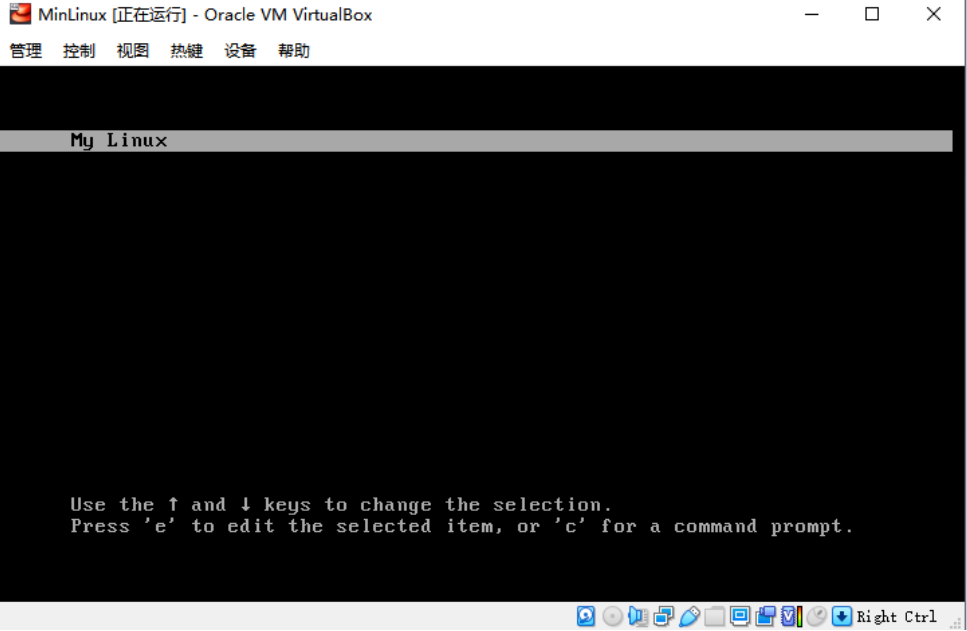
出错啦。。。
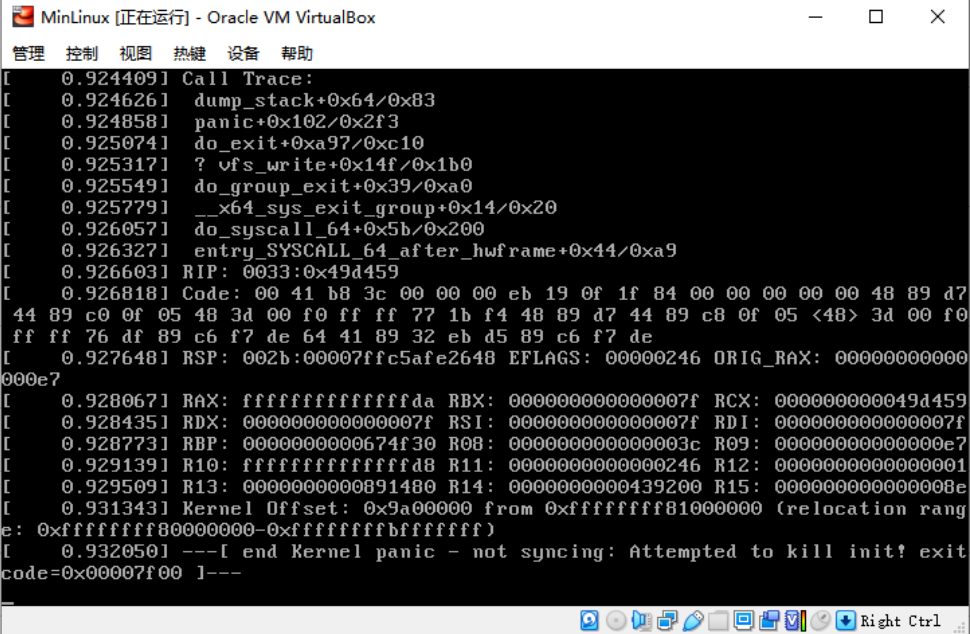
估计猜测分析:
由于系统启动的时候需要挂载/dev/sda2 这块真正的rootfs 系统,可是在加载内存镜像initrd.gz 后,想启动挂载rootfs的时候,找不到硬盘分区了。
这里有个我们打包的时候,在涉及 第三方模块如ext4 驱动的时候,是没有打包到内核中的,但是默认是支持扩展挂载的,所以采用修改initrd.gz 这个文件,这个时候就需要用到modules了(前面只是生成了,还没有用到,所以需要先把这个modules打包进initrd.gz中,让他能找到ext4驱动)同时也顺便把rootfs 的目录中也一并处理成镜像的样子。
sysroot 和initrd 两个目录一样操作:
1 cd /mnt/sysroot
2 cp ‐a /usr/src/modules/lib usr/ #复制modules进入这个文件夹
3 mkdir usr/lib64 #创建空文件夹,只是为了规范一点
4 ln ‐s usr/lib64 lib64
5 ln ‐s usr/lib lib
6 #initrd 同样操作
7 cd /usr/src/initrd
8 cp ‐a /usr/src/modules/lib usr/ #复制modules进入这个文件夹
9 mkdir usr/lib64 #创建空文件夹,只是为了规范一点
10 ln ‐s usr/lib64 lib64
11 ln ‐s usr/lib lib
12 # 重新生成initrd.gz 由于模块我没有精简所以耗时比较久
13 find . | cpio ‐H newc ‐‐quiet ‐o | gzip ‐9 > /usr/src/initrd.gz
14 # 替换 旧的initrd.gz
15 cp initrd.gz /mnt/boot/通过修改init文件,我虽然进去了镜像系统,但是由于始终没有找到硬盘,导致rootfs没有能进入,也请各位大神帮忙解开这个结,我不知道哪里出了问题。
开始修改 init 不进行rootfs转换,直接进入内存系统:
1 #!/bin/sh
2
3 echo "Mounting proc and sys..."
4 mount ‐t sysfs sysfs /sys
5 mount ‐t proc proc /proc
6
7 echo "Detect and export hardware infomation..."
8 mdev ‐s
9
10 exec /bin/sh
11 把项目两句话注释掉,改成直接执行 exec /bin/sh 作为主进程
12
13 echo "Mount real rootfs to /mnt/sysroot..."
14 #mount ‐t ext4 ‐o ro /dev/sda2 /mnt/sysroot
15
16 echo "Switch to real rootfs..."
17 # exec chroot /mnt/sysroot /sbin/init这个时候内存系统进去了:
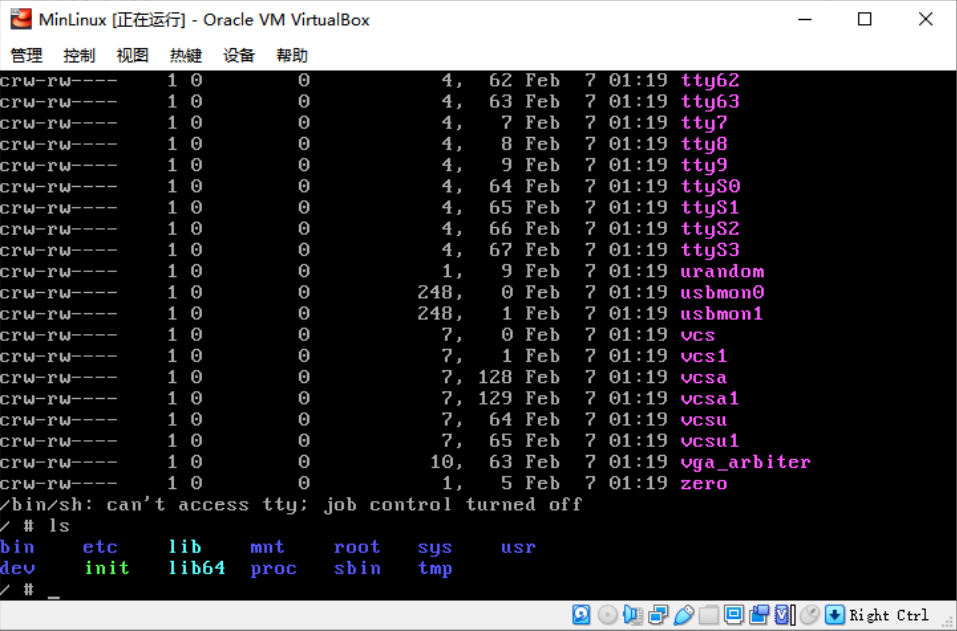
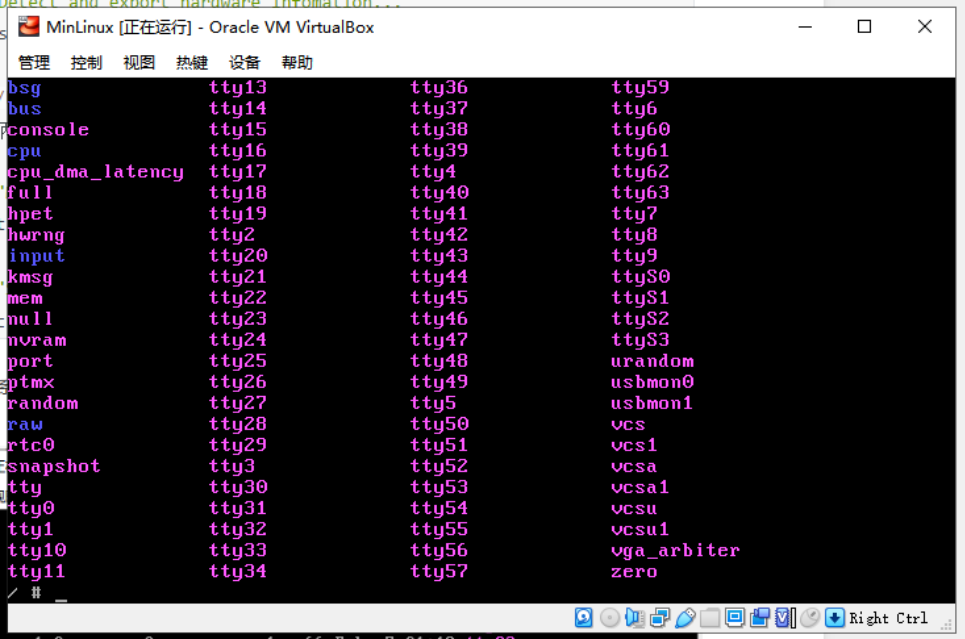
但是根本但是在/dev/ 下根本没有sdaX的硬盘分区。首先驱动也是有的,通过grub也是能看到的。
cat /proc/filesystems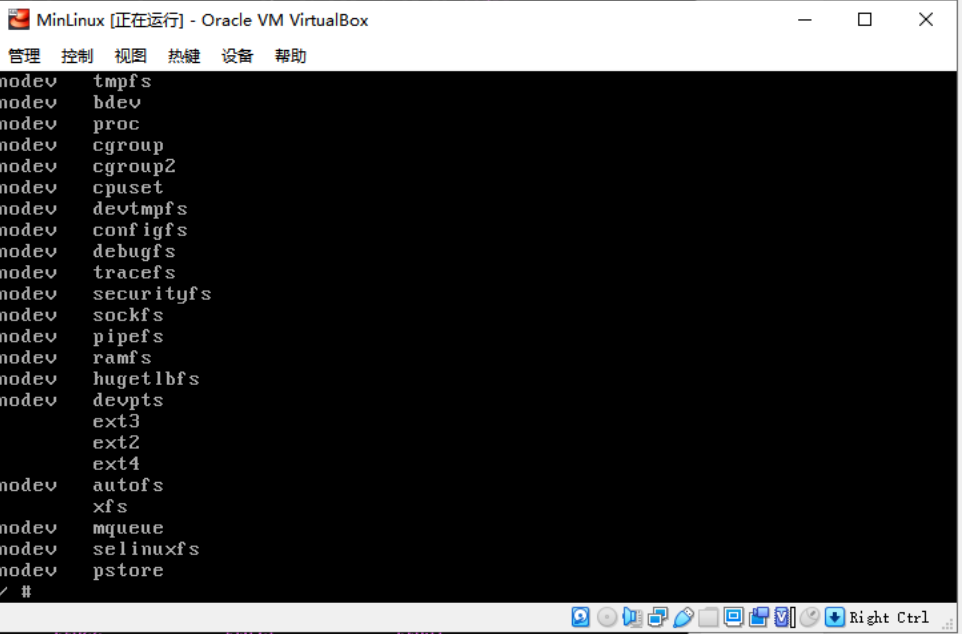
进入刚刚启动时候的grub界面,是能看到硬盘分区的:
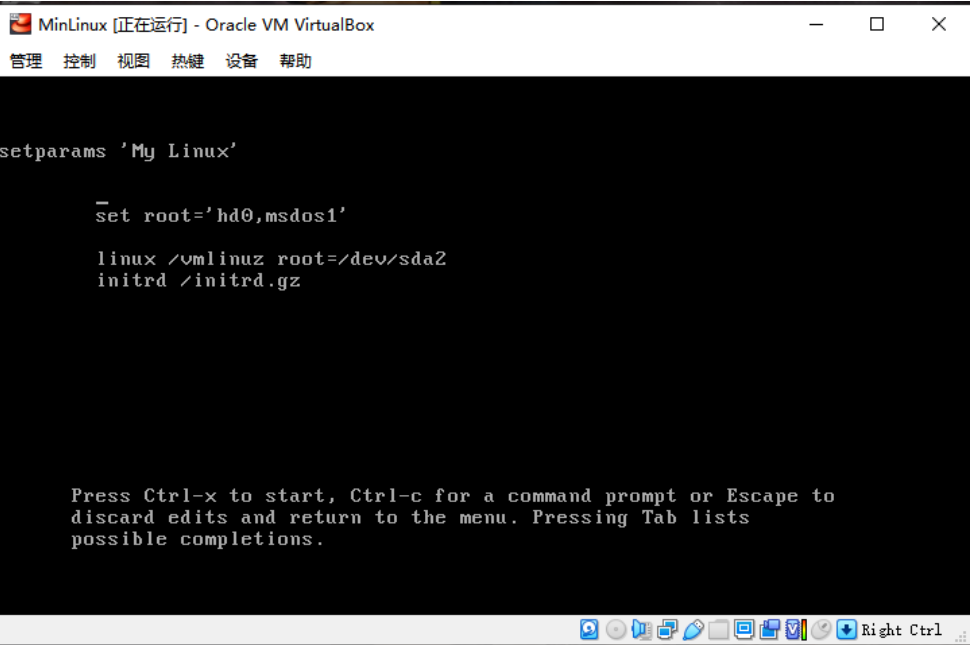
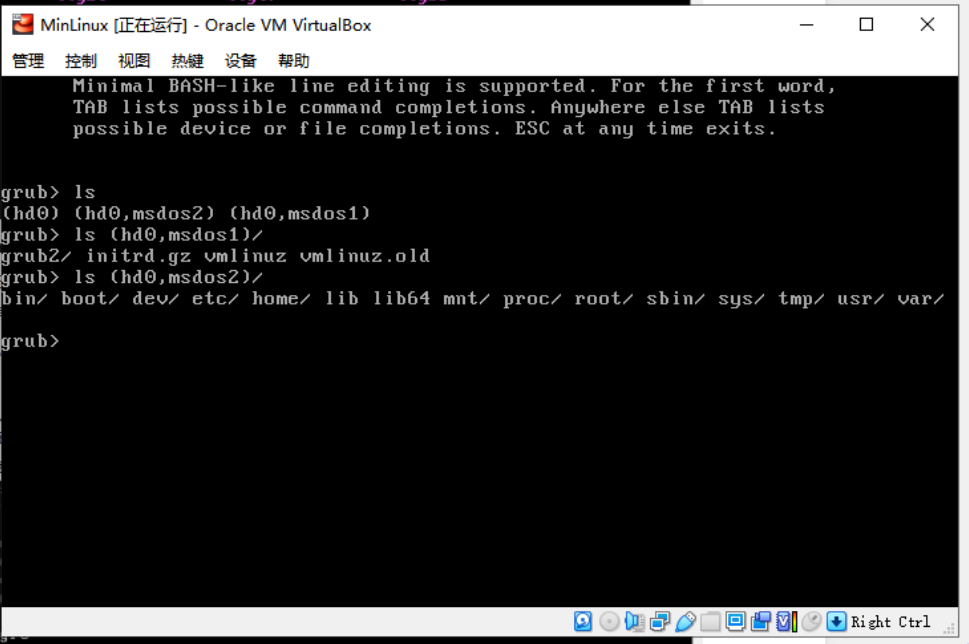
---硬盘找不到的问题已经解决,补充进去:
通过修改配置linux kernel 已经解决硬盘找不到的问题:
Device Drivers > SCSI device Support >SCSI Disk Support
SCSI generic support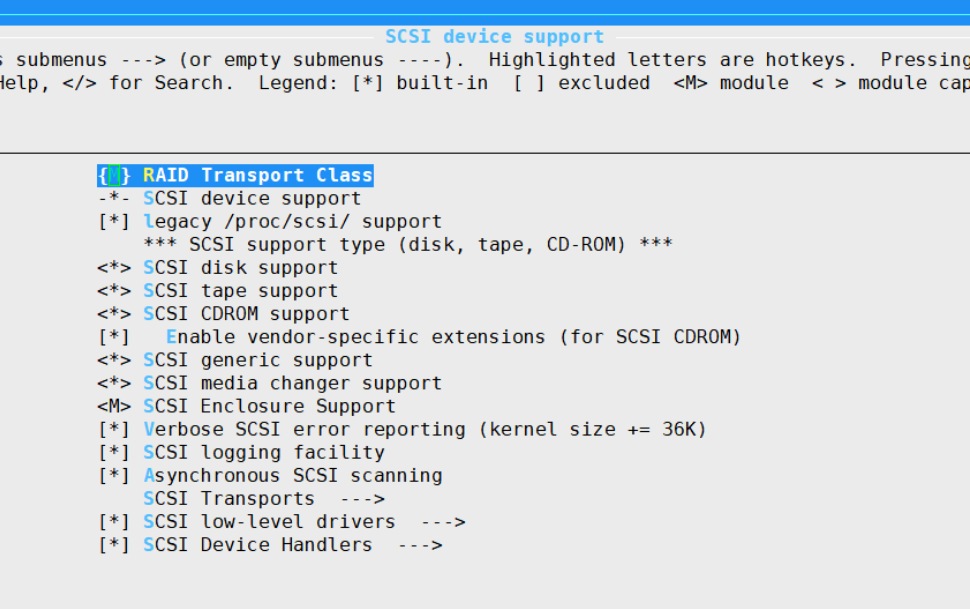
以上通过修改内核kernel配置后,终于找到了硬盘:
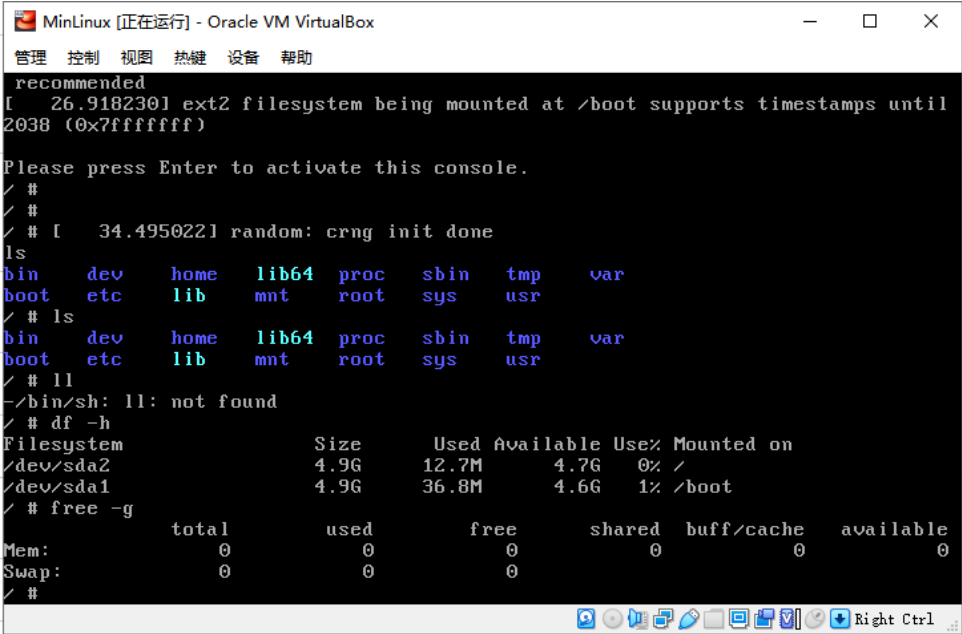
使用 linux kernel +busybox 定制linux系统的更多相关文章
- [中英对照]Linux kernel coding style | Linux内核编码风格
Linux kernel coding style | Linux内核编码风格 This is a short document describing the preferred coding sty ...
- Linux Kernel - Debug Guide (Linux内核调试指南 )
http://blog.csdn.net/blizmax6/article/details/6747601 linux内核调试指南 一些前言 作者前言 知识从哪里来 为什么撰写本文档 为什么需要汇编级 ...
- Linux kernel pwn notes(内核漏洞利用学习)
前言 对这段时间学习的 linux 内核中的一些简单的利用技术做一个记录,如有差错,请见谅. 相关的文件 https://gitee.com/hac425/kernel_ctf 相关引用已在文中进行了 ...
- Intel 80x86 Linux Kernel Interrupt(中断)、Interrupt Priority、Interrupt nesting、Prohibit Things Whthin CPU In The Interrupt Off State
目录 . 引言 . Linux 中断的概念 . 中断处理流程 . Linux 中断相关的源代码分析 . Linux 硬件中断 . Linux 软中断 . 中断优先级 . CPU在关中断状态下编程要注意 ...
- Linux Kernel 本地内存损坏漏洞
漏洞名称: Linux Kernel 本地内存损坏漏洞 CNNVD编号: CNNVD-201310-663 发布时间: 2013-11-05 更新时间: 2013-11-05 危害等级: 漏洞类 ...
- Linux kernel 内存损坏漏洞
漏洞名称: Linux kernel 内存损坏漏洞 CNNVD编号: CNNVD-201310-143 发布时间: 2013-10-11 更新时间: 2013-10-11 危害等级: 中危 漏洞类 ...
- Linux kernel ‘fib6_add_rt2node’函数安全漏洞
漏洞名称: Linux kernel ‘fib6_add_rt2node’函数安全漏洞 CNNVD编号: CNNVD-201307-265 发布时间: 2013-07-16 更新时间: 2013-07 ...
- Linux kernel ‘ip6_sk_dst_check’函数拒绝服务漏洞
漏洞名称: Linux kernel ‘ip6_sk_dst_check’函数拒绝服务漏洞 CNNVD编号: CNNVD-201307-070 发布时间: 2013-07-05 更新时间: 2013- ...
- 从基本理解到深入探究 Linux kernel 通知链(notifier chain)【转】
转自:https://blog.csdn.net/u014134180/article/details/86563754 版权声明:本文为博主原创文章,未经博主允许不得转载.——Wu_Being ht ...
随机推荐
- 通过示例学习rholang(上部:课程0-6)
通过例子和实践来学习rho语言.下面的例子和练习都很值得去运行.阅读.修改和完善.修改练习和教程中任何你感到有意思的代码,这样能够获得最好的学习效果.该教程包含了rho语言最常见以及最重要的特性,足以 ...
- 手撸一个SpringBoot的Starter,简单易上手
前言:今天介绍一SpringBoot的Starter,并手写一个自己的Starter,在SpringBoot项目中,有各种的Starter提供给开发者使用,Starter则提供各种API,这样使开发S ...
- PBR原理
漫反射和镜面反射 漫反射和镜面反射(或反射)光是描述光和材料之间两种主要相互作用类型的两个术语.镜面光是指从表面反弹的光.在光滑的表面上,这种光将反射所有相同的方向,并且表面将呈现镜像.漫射光是被吸收 ...
- php--->查询超大文件(12G)
今天遇到一个要在一个12G日志中查询数据的需求,手中暂时没有查询这种超大文件的工具,于是自己写了一个程度来读这个超大文件 其整体思路就是一行一行地去读取超大文件中的数据,然后将拿出的一行数据做相应的查 ...
- SqlServer 利用游标批量更新数据
SqlServer 利用游标批量更新数据 Intro 游标在有时候会很有用,在更新一部分不多的数据时,可以很方便的更新数据,不需要再写一个小工具来做了,直接写 SQL 就可以了 Sample 下面来看 ...
- IDEA debug下取消后续操作
有时进行测试时,不想后面的代码执行 具体应该怎么请看下文: 测试代码 public class demo { public static void main(String[] args) { Syst ...
- 自动化运维之Ansible入门
Ansible简介 Ansible是什么? Ansible 简单的说是一个配置管理系统(ConfiGuration Management System).你只需要可以使用ssh访问你的服务器或设备.它 ...
- 深入SpringMVC注解
原文链接:https://blog.csdn.net/chenpeng19910926/article/details/70837756 @Controller 在SpringMVC 中提供了一个非常 ...
- Hyper-V虚拟机设置外部网络访问
在Hyper-V管理器中新建一个虚拟交换机,类型为 内部 ,修改名称为 nat 在虚拟机的设置页面中,将网络适配器设置为新建的虚拟交换机 nat 打开win10->控制面板->网络和共享中 ...
- 如何优雅地打印一个Java对象?
你好呀,我是沉默王二,一个和黄家驹一样身高,和刘德华一样颜值的程序员.虽然已经写了十多年的 Java 代码,但仍然觉得自己是个菜鸟(请允许我惭愧一下). 在一个月黑风高的夜晚,我思前想后,觉得再也不能 ...
